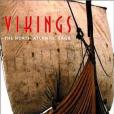內容簡介
The story of the Viking expansion west across the North Atlantic between AD. 800 and 1000, the settlement of Iceland and Greenland, and the exploration of northeastern North America, is a chapter of history that deserves to be more widely known. Norse discoveries in the North Atlantic are the first step in the process whereby human populations became connected into a single gl...(展開全部) The story of the Viking expansion west across the North Atlantic between AD. 800 and 1000, the settlement of Iceland and Greenland, and the exploration of northeastern North America, is a chapter of history that deserves to be more widely known. Norse discoveries in the North Atlantic are the first step in the process whereby human populations became connected into a single global system.The Norse, and their Viking ancestors, are little known, misunderstood, and almost invisible on the American landscape. Although Norse voyages were known since the early 1800’s, the near absence of physical evidence of Vikings in the New World has rendered the information, and the possibility that Norse explorers reached the North American mainland five hundred years before Columbus, speculative, at best. Yet, discovery of a Viking site in Newfoundland in 1960 confirmed a pre-Columbian European presence in the Americas, and Norse artifacts found in archaeological sites scattered throughout the eastern Canadian arctic and sub-arctic, raise the issue of how far south of Newfoundland the Norse did explore, and what impact their contacts had on Native Americans. The term "Viking" is indelibly associated with seafaring warriors. Carpentry, and especially boat building, were skills known to all Viking men, and along with maritime skill, was the characteristic upon which Viking expansion and influence depended. Viking craft had an advantage over all other watercraft of their day in speed, shallow draft, weight, capacity, maneuverability, and seaworthiness, giving Vikings

